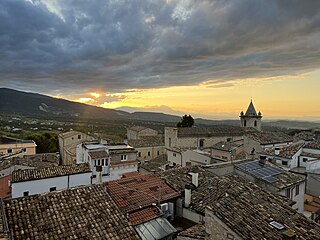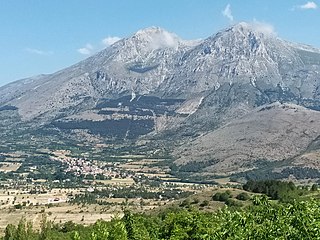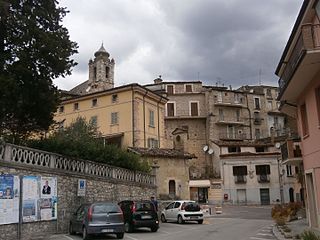
Abruzzo, historically known as Abruzzi, is a region of Southern Italy with an area of 10,763 square km and a population of 1.3 million. It is divided into four provinces: L'Aquila, Teramo, Pescara, and Chieti. Its western border lies 80 km (50 mi) east of Rome. Abruzzo borders the region of Marche to the north, Lazio to the west and north-west, Molise to the south and the Adriatic Sea to the east. Geographically, Abruzzo is divided into a mountainous area in the west, which includes the highest massifs of the Apennines, such as the Gran Sasso d'Italia and the Maiella, and a coastal area in the east with beaches on the Adriatic Sea.

The province of L'Aquila is the largest, most mountainous and least densely populated province of the Abruzzo region of Italy. It comprises about half the landmass of Abruzzo and occupies the western part of the region. It has borders with the provinces of Teramo to the north, Pescara and Chieti to the east, Isernia to the south and Frosinone, Rome and Rieti to the west. Its capital is the city of L'Aquila.

Ortona is a coastal town and municipality of the Province of Chieti in the Italian region of Abruzzo, with some 23,000 inhabitants.

Avezzano is a city in the Abruzzo region, province of L'Aquila, Italy. It is the second most populous municipality in the province and the sixth in the region. It is the main commercial, industrial and agricultural centre of the Marsica area, with important high-tech industries and the Fucino Space Centre.

Guardiagrele is a town and comune in the province of Chieti, part of the Abruzzo region of central Italy. It is in the foothills of the Maiella mountain at an elevation of around 576 metres (1,890 ft). Its population numbers about 10,000.

Penne is an Italian town in the province of Pescara, in the Abruzzo region, in mid-southern Italy. According to the last census in 2014 the population was 12,451. It is one of I Borghi più belli d'Italia.

Scanno is a town and district in the province of L'Aquila, in the Abruzzo region of central Italy. It is one of I Borghi più belli d'Italia.

Tagliacozzo is a town and comune in the province of L'Aquila, Abruzzo, central Italy. It is one of I Borghi più belli d'Italia.

Balsorano is a comune (municipality) and town in the province of L'Aquila in the Abruzzo region of Italy.

Barisciano, is a comune and town in the province of L'Aquila in the Abruzzo region of central Italy. It is located in the Gran Sasso e Monti della Laga National Park.

Cerchio is a comune and town in the province of L'Aquila in the Abruzzo region of southern Italy.

Massa d'Albe is a comune and town in the province of L'Aquila in the Abruzzo region of central Italy. It is part of the Marsica.

Montereale is a comune and town in the province of L'Aquila, in the Abruzzo, region of Italy. It is located in the Gran Sasso e Monti della Laga National Park.
Pescocostanzo is a comune and town of 1038 inhabitants in the Province of L'Aquila in the Abruzzo region of Italy. It is a tourist destination, attracting people from all over Italy due to its landscape and environment. It is part of the Maiella National Park and is one of I Borghi più belli d'Italia. In winter, Pescocostanzo is a destination for skiers and snowboarders, and has its own ski resort. The towns of Roccaraso and Rivisondoli are close by.

Roccaraso is a town and comune in central Italy, in the province of L'Aquila in the Abruzzo region.

Alanno is a comune and town in the province of Pescara in the Abruzzo region of Italy.
Sant'Eufemia a Maiella is a town and comune in the province of Pescara, Abruzzo, central Italy. It is located in the Maiella National Park in a valley enclosed by the western slopes of the Majella massif, and the northeastern slopes of the Morrone group.

Isola del Gran Sasso d'Italia is a town and comune in province of Teramo in the Abruzzo region of southern Italy. It is located in the Gran Sasso e Monti della Laga National Park. The Gran Sasso mountain is the highest mountain in the Apennine chain in Italy.

Tourism in Abruzzo has become one of the most prosperous sectors in the economy of Abruzzo, and in recent years has seen a remarkable growth attracting numerous tourists from Italy and Europe. According to statistics, in 2021 arrivals totaled 1,330,887. A total of 5,197,765 arrivals were tourists, a figure that puts the region seventeenth among the Italian regions for numbers of tourists per year. A moderate support to tourism is also given to the Abruzzo Airport with many low cost and charter flights connecting the entire region with the rest of Europe.

The Abbey of Santa Maria della Vittoria was a Cistercian monastery located in Scurcola Marsicana, Province of L'Aquila, Italy.






















